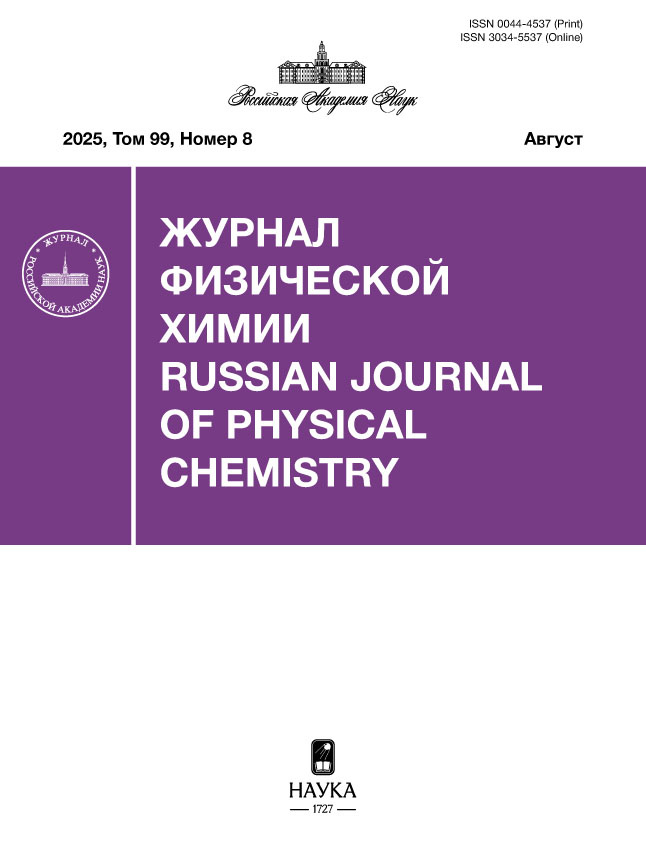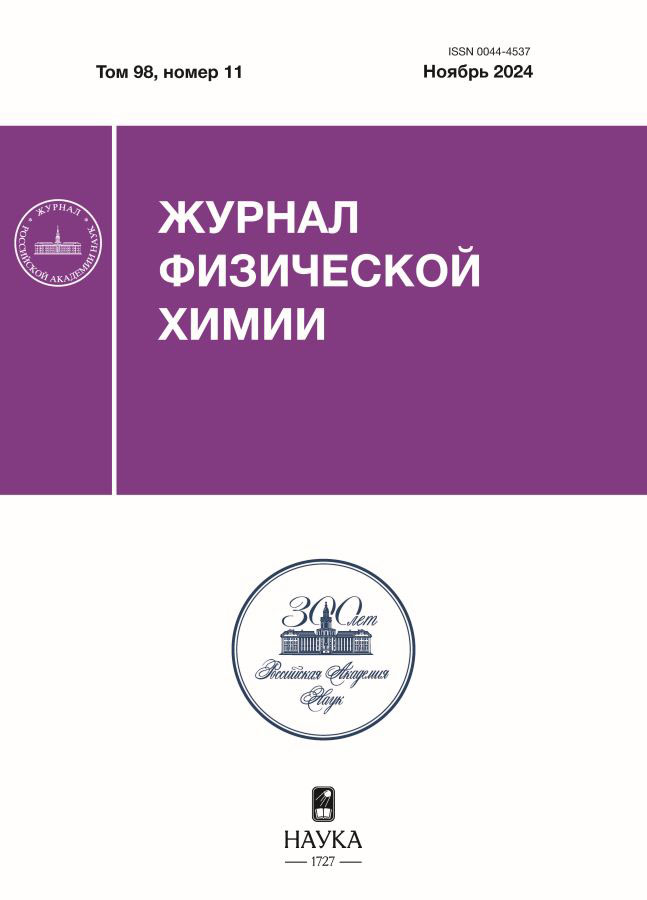Статистико-термодинамический анализ влияния химического состава на изменение температур плавления галогенидов щелочных металлов
- Авторы: Давыдов А.Г.1
-
Учреждения:
- Институт высокотемпературной электрохимии УрО РАН
- Выпуск: Том 98, № 11 (2024)
- Страницы: 14-23
- Раздел: ХИМИЧЕСКАЯ ТЕРМОДИНАМИКА И ТЕРМОХИМИЯ
- Статья получена: 29.05.2025
- Статья опубликована: 15.11.2024
- URL: https://rjdentistry.com/0044-4537/article/view/681003
- DOI: https://doi.org/10.31857/S0044453724110025
- EDN: https://elibrary.ru/FAPBOO
- ID: 681003
Цитировать
Полный текст
Аннотация
Предложена интерпретация зависимости температур плавления всего подкласса галогенидов щелочных металлов от химического состава, построенная на анализе изменения различных вкладов во внутреннюю энергию солей в расплавленной и кристаллической фазах с изменением суммы радиусов их катионов и анионов. Выражение для вычисления энергии жидкосолевых расплавов включает в себя вклад заряд-дипольных взаимодействий между ионами, который учитывается в работе на основе термодинамической теории возмущений с базисом в виде модели заряженных твердых сфер. Для энергии кристаллической фазы использованы формула Борна–Майера для электростатической части и формула Дебая для учета вклада колебаний. В рамках предложенного подхода дано объяснение причин более низких значений приведенных температур плавления галогенидов лития и натрия по сравнению с другими солями. Показано, что отклонения приведенных температур плавления галогенидов лития и натрия в зависимости от суммы ионных радиусов могут быть объяснены проявлением кулоновского и поступательного вкладов в энергию в расплавленном состоянии, а также вкладов Маделунга и Борна в кристаллической фазе.
Полный текст
Об авторах
А. Г. Давыдов
Институт высокотемпературной электрохимии УрО РАН
Автор, ответственный за переписку.
Email: A.Davydov@ihte.ru
Россия, Екатеринбург
Список литературы
- Lantelme F., Groult H. Molten Salts Chemistry: From Lab to Applications. Elsevier, 2013. 592 p.
- Chang Y.A., Chen S., Zhang F., et al. // Prog. Mater. Sci. 2004. V. 49. P. 313. doi: 10.1016/s0079-6425(03)00025-2
- Chartrand P., Pelton A.D. // Metall. Mater. Trans. A. 2001. V. 32. P. 1397. doi: 10.1007/s11661-001-0229-0
- Xing X., Zhu Z., Dai S., Tanaka T. // Thermochim. Acta. 2001. V. 372. P. 109. doi: 10.1016/s0040-6031(01)00441-5
- Kapała J., Bochyńska M., Broczkowska K., Rutkowska I. // J. Alloys Compd. 2008. V. 451. P. 679. doi: 10.1016/j.jallcom.2007.04.085
- Gong W., Wu Y., Zhang R., Gaune-Escard M. // Calphad. 2012. V. 36. P. 44. doi: 10.1016/j.calphad.2011.11.001
- Kubíková B., Mlynáriková J., Beneš O., et al. // J. Mol. Liq. 2018. V. 268. P. 754. doi: 10.1016/j.molliq.2018.07.114
- Beneš O., Zeller Ph., Salanne M., Konings R.J.M. // J. Chem. Phys. 2009. V. 130. Article No. 134716. doi: 10.1063/1.3097550
- Aragones J.L., Sanz E., Valeriani C., Vega C. // J. Chem. Phys. 2012. V. 137. Article No. 104507. doi: 10.1063/1.4745205
- Dewan L.C., Simon C., Madden P.A., et al. // J. Nucl. Mater. 2013. V. 434. P. 322. doi: 10.1016/j.jnucmat.2012.12.006
- DeFever R.S., Wang H., Zhang Y., Maginn E.J. // J. Chem. Phys. 2020. V. 153. Article No. 011101. doi: 10.1063/5.0012253
- Wang H., DeFever R.S., Zhang Y., et al. // J. Chem. Phys. 2020. V. 153. Article No. 214502. doi: 10.1063/5.0023225
- Stillinger F.H. Equilibrium Theory of Pure Fused Salts. John Wiley & Sons, 1964. 108 p.
- Давыдов А.Г., Ткачев Н.К. // Расплавы. 2023. № 2. С. 167. doi: 10.31857/S0235010623020032
- Пригожин И., Дефэй Р. Химическая термодинамика. Новосибирск: Наука, 1966. 512 с.
- Укше Е.А. Строение расплавленных солей. Москва: Мир, 1966. 431 с.
- Ландау Л.Д., Лифшиц Е.М. Теоретическая физика. Т. 5. Статистическая физика. Ч. 1. Москва: Физматлит, 2013. 620 с.
- Blum L. Primitive Electrolytes in the Mean Spherical Approximation. Academic Press, 1980. 66 p.
- Hiroike K. // Mol. Phys. 1977. V. 33. P. 1195. doi: 10.1080/00268977700101011
- Solana J.R. Perturbation Theories for the Thermodynamic Properties of Fluids and Solids. CRC Press: Taylor & Francis Group, 2013. 400 p.
- Born M., Mayer J.E. // Z. Phys. 1932. V. 75. P. 1.
- Mayer J.E., Mayer M.G. Statistical Mechanics. John Wiley & Sons, 1940. 495 p.
- Магомедов М.Н. // ТВТ. 1992. Т. 30. С. 1110.
- Sirdeshmukh D.B., Sirdeshmukh L., Subhadra K.G. Alkali Halides: A Handbook of Physical Properties. Springer-Verlag, 2001. 299 p.
- Tosi M.P., Fumi F.G. // J. Phys. Chem. Solids. 1964. V. 25. P. 45. doi: 10.1016/0022-3697(64)90160-x.
- Ashcroft N.W., Mermin N.D. Solid State Physics. Harcourt College Publishers, 1976. 848 p.
- Batsanov S.S., Batsanov A.S. Introduction to Structural Chemistry. Springer Science + Business Media, 2012. 542p.
- Wilson J.N., Curtis R.M. // J. Phys. Chem. 1970. V. 74. P. 187. doi: 10.1021/j100696a034
- Fisher M.E. // J. Stat. Phys. 1994. V. 75. P. 1. doi: 10.1007/BF02186278
- Haynes W.M. CRC Handbook of Chemistry and Physics: 97th Edition. CRC Press: Taylor & Francis Group, 2017. 2643 p.
Дополнительные файлы




















